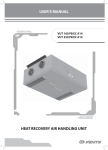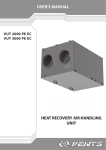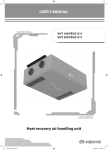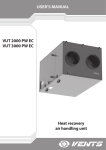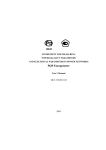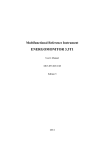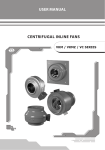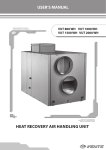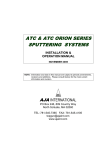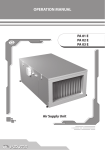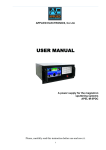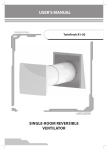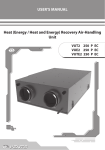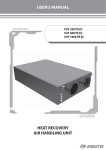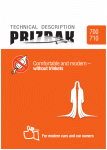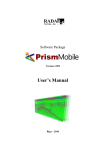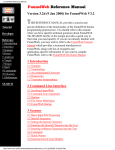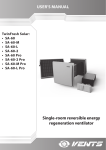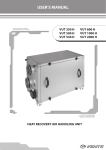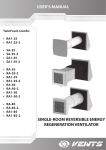Download User`s manual "VENTS VUT EH" ( PDF 3,61Mb )
Transcript
USER`S MANUAL VUT 350 EH VUT 500 EH VUT 530 EH VUT 600 EH VUT 800 EH VUT 1000 EH VUT 1500 EH VUT 2000 EH Heat recovery air handling unit 2 CONTENT Introduction Use Delivery set Structural designation key Technical data Safety requirements Structure and operating logic Mounting and set-up Condensate drain Connection to power mains Unit control Maintenance Fault handling Storage and transportation rules Manufacturer’s warranty Acceptance certificate Electrical connection certificate Acceptance certificate Seller’s information Mounting certificate Warranty card 3 3 3 3 3 6 7 9 10 11 14 20 21 22 22 23 23 23 23 23 24 VUT EH 3 INTRODUCTION The present user manual consisting of technical details, operating instructions and technical specification covers the installation of the VUT...EH air handling unit with heat recovery, VENTS series, hereinafter referred as the unit. USE The unit with a heat exchanger and an electric heater is a heat recovery device and is one of the energy saving components used in buildings and premises. The unit is a component unit and is not designed for independent operation. The unit enables continuous air exchange by means of mechanical ventilation in private residences, offices, hotels, cafes, conference rooms, etc. as well as recovery of the waste heat energy contained in the extract air to warm up the clean supply air. Transported air must not contain any flammable or explosive mixtures, evaporation of chemicals, coarse dust, soot and oil particles, sticky substances, fibrous materials, pathogens or any other harmful substances. The unit is not intended to be used by children, physically or mentally disabled persons, persons with sensory disorder, persons with no appropriate qualification. Any operations with the unit must be performed only by properly qualified personnel after the appropriate safety briefing. The unit installation sites must prevent access by unattended children. DELIVERY SET Unit - 1 item; Wall-mounted control panel - 1 item; User’s manual - 1 item; Packing box - 1 item. DESIGNATION KEY VUT ХХХ EH Spigot orientation: H - horizontal Heater type E - electric Air capacity [m3/h] 350, 500, 530, 600, 800,1000,1500, 2000 Unit type VUT - heat recovery ventilation TECHNICAL DATA The unit is designed for indoor application with the ambient temperature ranging from +1 °C up to +40 °C and relative humidity up to 80%. The unit is classified as a class I electric appliance. Hazardous parts access and water ingress protection standard: Unit motors - IP 44; Unit assembly connected to air ducts - IP 22. For the main overall and connecting dimensions, outer view and technical data, refer to Fig. 1, 2 and in Tables 1, 2 and 3. The unit design is regularly improved, so some models may slightly differ from those ones described in this manual. B 4 F I K Ø D A H C G E Fig. 1. VUT 350…600 EH overall and connecting dimensions Table Табл. 1 Type Dimensions [mm] A B C D E F G H I K VUT 350 EH 996 403 954 124 1057 554 497 100 119 111 VUT 500 EH 996 403 954 149 1057 554 497 100 119 111 VUT 530 EH 996 403 954 159 1057 554 497 100 119 111 VUT 600 EH 996 403 954 199 1057 554 497 100 119 111 VUT EH 5 M K G F L ØD C A E I B H Fig. 1. VUT 800…2000 EH overall and connecting dimensions Table 2 Type Dimensions [mm] I K L M VUT 800 EH 1117 460 A B 1071 C 249 1176 D E 832 F 698 613 G H 80 126 154 386 VUT 1000 EH 1117 460 1071 249 1176 832 698 613 80 126 154 386 VUT 1500 EH 1394 581 1345 314 1447 947 814 842 200 394 201 320 VUT 2000 EH 1394 581 1345 314 1447 947 814 842 200 394 201 320 6 Table 3 VUT 350 EH VUT 500 EH Max. fan power [W] 2 items х 130 2 items х 150 Max. fan current [A] 2 items х 0,60 Electric heater power [kW] 3,0 Type VUT 600 EH VUT 800 EH VUT 1000 EH 2 items х 150 2 items х 195 2 items х 245 2 items х 410 2 items х 490 2 items х 650 2 items х 0,66 2 items х 0,66 2 items х 0,86 2 items х 1,08 2 items х 1,8 2 items х 2,15 2 items х 2,84 3,0 4,0 4,0 9,0 9,0 18,0 18,0 Supply voltage, 50 Hz [V] VUT 530 EH 1~230 VUT 1500 EH VUT 2000 EH 3~400 Electric heater current [A] 13 13 17,4 17,4 13 13 26 26 Total unit power [kW] 3,26 3,3 4,3 4,39 9,49 9,8 18,98 19,30 Total unit current [A] 14,2 14,32 18,72 19,1 15,16 16,6 30,3 31,7 Max. air capacity, m /h 350 500 530 600 800 1200 1750 2200 3 Rotation speed [min ] 1150 1100 1100 1350 1650 1850 1100 1150 Noise level, 3 m [dB(A)] 24-45 28-47 28-47 32-48 48 60 49 65 Transported air temperature [°C] -25 up to +55 -25 up to +50 -25 up to +50 -25 up to +55 -25 up to +45 -25 up to +40 -25 up to +45 -25 up to +40 -1 Casing material aluzinc Insulation 25 mm mineral wool 50 mm mineral wool extract Filter: G4 supply Connected air duct diameter [mm] F7 G4 (F7)* Ø 125 Ø 150 Ø 160 Weight [kg] 45 49 49 Heat recovery efficiency [%] up to 78 up to 88 Ø 200 Ø 250 Ø 315 54 85 96 up to 85 up to 78 up to 77 Heat exchanger type cross flow Heat exchanger material aluminium *option SAFETY REQUIREMENTS While operating and mounting the unit consider the requirements of the present operation manual as well as general requirements of all applicable local and national building and electrical codes and standards. The unit must be grounded! Before connecting the unit to power mains make sure that the unit is free of any visible damages or any other foreign objects inside the casing that can damage the impeller blades. Mounting and connection of the unit to power mains only by duly qualified electricians with valid electric work permit! The unit is not rated for operation in an environment that contains toxic or aggressive substances as acids, alkalis, organic solvents, soot, paint as well as sputtered particles of explosive or aggressive substances. The unit is not rated for use in areas where atmospheric conditions are determined by sea climate or hot springs. Disconnect the unit from power supply prior to mounting, maintenance, connection and repair works! Do not! • Do not operate the unit beyond the specified temperature range or in an aggressive and explosive medium! • Do not connect clothes dryers or similar equipment to the ventilation system! • Do not operate the unit in the air and dust mixture medium! VUT EH 7 DESIGN AND OPERATING LOGIC The unit has the following operating logic, Fig.3: Warm stale extract air from the room flows through the air ducts to the unit, where it is filtered, then air flows through the heat exchanger and is exhausted outside by the extract fan through the air ducts. Clean cold air from outside is moved by the supply fan to the unit, where from it is directed to the supply filter. Then filtered air flows through the heat exchanger and moves to the room through the air ducts. Heat energy of warm extract air is transferred to clean intake fresh air from outside and warms it up. Heat recovery minimizes thermal energy losses, energy demand and operating costs for supply air heating accordingly. The unit is a framework construction that includes six rigidly fixed 25 mm (for the VUT 350...600 EH units) and 50 mm (for the VUT 800...2000 EH units) thick sandwich panels. The three-layer sandwich panels are made of two galvanized steel sheets, internally filled with thermal- and sound-insulated layer of mineral wool. The air supply and exhaust units are equipped with quick-release access panels with special gaskets for easy repair and maintenance. The terminal box (see Fig. 4: item 13 for VUT 350..600 EH) or the control unit (see Fig. 4: item 10 for VUT 800..2000 EH) contains the terminal block. The power and ground cables are routed to the terminal block through sealed lead-ins. Extract air Supply air Fig. 3. Operating logic Intake air Exhaust air 8 3 4 12 VUT 350…600 EH 5 1. Supply fan 2. Extract filter 3. Heat exchanger 4. Supply filter 5. Extract filter 6. Drain pipe 7. Electric heater 8. Bypass 9. Wall-mounted control panel 10. Control unit 11. Drain pan 12. Quick-detachable panels 13. Terminal box 9 2 6 11 7 8 10 5 1 10 13 VUT 800…2000 EH 9 4 8 7 1 3 2 11 6 12 Fig. 4. Unit design The basic unit configuration includes: a wall-mounted control panel with a cable connection to the control system; supply and exhaust fans with forward-curved impeller blades, maintenance-free electric motors with external rotors and builtin thermal protection; cross-flow plate heat exchanger; electric heater with overheating protection: two thermal switches, one of which is a safety switch (+60 °C) with automatic reset on temperature dropping back to normal and the other is an emergency switch (+90 °C) with manual reset on pressing the «RESET» button; supply air filter (filter class (F7)); extract air filter (filter class G4). VUT EH 9 MOUNTING AND SET-UP The unit is suspended to the mounting surface through the threaded rod fixed inside the threaded dowel. The unit is also suitable also for mounting to a horizontal mounting surface, Fig. 5. While mounting the unit provide the minimum required access to the unit for maintenance and repair. The required minimum distances from the unit to the wall is shown in Fig. 6. Suspended mounting Example nut washer vibration-absorbing rubber nut and lock-nut Mounting to horizontal surface Fig. 5. Unit mounting 500 A A = 600 mm (VUT 350-1000 EH) А = 850 mm (VUT 1500-2000 EH) Fig. 6. Minimum unit mounting distances 10 Precautions: The unit is designed for mounting on a rigid and stable structure in compliance to the technical data and unit weight. The unit is mounted with anchor bolts. Make sure that a mounting construction has sufficient load capacity for the unit weight. Otherwise reinforce an installation place by beams, etc. Then insert threaded rods inside the threaded dowels in the ceiling. If the construction rigidity is not sufficient enough it can resonate with the unit and generate abnormal noise and vibration. While mounting the unit provide enough service space and an access door for maintenance of the filters, heat exchanger and fans. One access door is required for each unit. For details, refer to the outline drawing, fig. 1. Install anchor bolts M8 into the fixation for the ceiling suspension mount and fix it with nuts and washers. Make sure the unit casing has no foreign objects inside, like paper and foil. If the threaded bolts used for the unit mounting are too short the unit can generate abnormal noise and resonate with the ceiling. If the unit connection place to the spiral seam duct is supposed to be the source of the abnormal noise, replace the spiral air duct with a flexible air duct. The precautions referred above are normally sufficient to solve the resonance problem. The flexible connectors may be also installed to troubleshoot the resonating problem. To attain the best performance of the unit while mounting provide a straight 1 m duct section on both sides of the unit. Access to the unit must be prevented by installing a protecting grille or any other device with the mesh width up to 12.5 mm. CONDENSATE DRAINAGE min 3 ° The unit must be connected to sewage collection system, fig. 7. Connect the pipe, U-trap (not included in delivery package) and sewage collection system with metal, plastic or rubber connecting pipes, fig. 7. The pipe slope downwards must be at least 3°. Fill up the system with water before connecting the unit to the power mains! The U-trap must be filled with water at all times during the unit operation. Make sure that the water flows freely into the sewage collection system or otherwise condensed water may build up in the unit during heat recovery. The condensate drainage system is designed for normal operation in premises with air temperatures above 0 °C. If the expected air temperatures are below 0 °C the condensate drainage system must be equipped with heat insulation and pre-heating facilities. min 3° drain pipe tube U-trap tube sewage system Fig. 7. Condensate drainage Do not connect several drain pipes from several air handling units to one U-trap! Direct condensate outside without connection to drain system is not allowed! VUT EH 11 POWER MAINS CONNECTION CONNECTION TO POWER MAINS SHALL ONLY BE PERFORMED BY QUALIFIED PERSONNEL AFTER CAREFUL READING OF THE USER’S MANUAL. THE UNIT IS INTENDED FOR AC MAINS SUPPLYING THE VOLTAGE COMPLIANT WITH THE TECHNICAL DATA TABLE. CHECK THE CABLE FOR CHOKING. DO NOT TURN ON THE UNIT IF THE CABLE IS DAMAGED. NEVER UNPLUG THE UNIT FROM THE SOCKET WITH WET HAND OR BY HOLDING THE ELECTRIC CABLE. THE RATED ELECTRICAL PARAMETERS OF THE UNIT ARE GIVEN ON THE MANUFACTURER’S LABEL. ANY TAMPERING WITH THE INTERNAL CONNECTIONS IS PROHIBITED AND WILL VOID THE WARRANTY. VUT 350..600 EH units must be connected to single-phase 230 / 50 Hz AC mains. VUT 800..2000 EH units must be connected to threephase 400 V / 50 Hz AC mains depending on the unit type (see Table 3 and Fig. 8). The connection must be made using durable, insulated and heat-resistant conductors (cables and wires) of appropriate section (see Table 4). The above conductor cross sections are for reference only. The conductor section selection shall account for the wire type, maximum permissible wire heating, insulation, length and installation method. Use only copper core wires. The unit must be properly grounded. The unit shall be connected to power mains on the terminal block mounted inside the terminal block (VUT 350..600 EH) or inside the control unit (VUT 800..2000 EH) in accordance with the external connections diagram and terminal designations. All the control and power wires must be connected according to the terminal markings and the electric polarity! The unit must be connected to the power mains via an automatic circuit breaker with a magnetic breaker integrated into the house cabling . The trip current shall be at least equal to the rated current consumption of the unit (see Table 3 and 4). Single-phase mains (VUT 350… 600 EH) L ~230 V 50 Hz N PE QF X1 L 1 N 2 РЕ 3 Three-phase mains (VUT 800… 2000 EH) ~400 V 50 Hz X1 QF L1 L1 1 L2 2 L3 3 N 4 РЕ 5 L2 L3 N PE Unit Unit Fig. 8. Unit wiring diagrams Table 4 Type Automatic circuit breaker rated current Copper-core cable VUT 350..600 EH 20 A, single-phase 3 х 2,5 mm2 VUT 800..1000 EH 20 A, three-phase 5 х 2,5 mm2 VUT 1500..2000 EH 40 A, three-phase 5 х 4 mm2 12 External devices. The control panel has a built-in temperature sensor. Therefore, while installing the panel in the operating area ensure at least 1 m clearance from heating equipment, doors and windows. The panel is attached to the wall using the self-tapping screws supplied. The data cable connecting the control panel and the unit shall be routed separately from the power cables. The recommended minimum distance between the cables is 150 mm. The control panel is supplied pre-assembled and connected to the unit by the manufacturer. If the repeat installation is necessary, follow the following steps: Dismantle the control panel (see Fig. 9): a) Open the control panel box by pressing on the ends; b) Use a screwdriver to disconnect the cable from the terminal block; c) Disconnect the data cable. a) b) Fig. 9. Control panel disconnection Attach the cable as necessary. Assemble the control panel: a) Route the cable through the access hole in the bottom lid; b) Fix the control panel bottom lid where desired and ensure a secure fit of the lid to the wall by tightening the self-tapping screw. The screw head must be clear of the control panel circuit board otherwise causing a risk of equipment damage! c) Strip the cable of the protective insulation (~20 mm); d) Strip the wires (~6 mm); e) Attach the wires to the terminal block according to the markings on the label and the wire colouring: yellow+ greenВ brownА white ┴ f ) Snap the control panel casing in place. Run the cable through the sealed lead in the control unit casing and connect it to the terminal block contacts (Fig. 10). VUT EH 13 а) b) e) f) yellow green brown white + В А Fig. 10. Control panel connection The temperature sensors are pre-attached by the manufacturer. For sensor connections on the controller circuit board see Fig. 11. CONTROLLER CIRCUIT BOARD WALL-MOUNTED CONTROL PANEL Terminal block on the panel yellow + green В brown А white Data cable 1 2 3 4 Outdoor air t° sensor connector Fig. 11. Connection to controller circuit board Supply air t° sensor connector Controller circuit board terminal block yellow 1 green 2 brown 3 white 4 14 UNIT CONTROL 1. General description of the automatic control system. The unit is controlled via the remote-mounted control panel (Fig. 12). The physical «control panel-unit» data transfer channel is performed via a four-core data cable up to 10 m in length. The system enables supply and exhaust fan air capacity control in 3 speed increments: 1 - the minimum speed used in non-residential premises over weekends and holidays or in residential premises at night time; 2 - normal ventilation speed; 3 - intensive ventilation mode when extra air supply is required. The temperature sensors enable optimum operation mode selection by the system in order to maintain pre-set temperature in the air duct. The control panel is equipped with a temperature sensor thereby enabling maintaining of the set (user-defined) indoor temperature at the selected fan speed or in accordance with the set service function mode (see below). The necessary operation mode selection as well as the current parameters (i.e. indoor temperature, set temperature, fan speed and heater power) are indicated on the LCD display. The energy-saving optimization program calculates the heater power required to sustain the temperature on the premises with up to 1°C accuracy while adjusting the heater power to 1%. The air damper (bypass damper) protects the heat exchanger against freezing at low supply air temperature and, if necessary, excludes supply air from the heat exchange (heat exchanger bypass mode) in the cold ventilation mode. The system state monitoring program controls the operating parameters of the unit and initiates emergency shutdown in dangerous situations (i.e. heater overheating or communication loss) by sending corresponding signals to the control panel. Filter replacement warnings are displayed at user-defined intervals (see below). All the settings made by the user are saved in the non-volatile memory of the control panel. 2. Remote control panel. 2 3 9 1 4 5 6 7 8 1. Control panel display. 2. The right LED indicates an emergency or malfunction (steady glow) or filter replacement necessity (blinking). 3. Temperature sensor. 4. «Up» button - menu navigation (cursor up) or increasing the current parameter value. 5. «Down» button - menu navigation (cursor down) or decreasing the current parameter value. «Enter» button - selecting the parameter for modification or jumping one menu level down (entering the menu from the main operation window). 7. «Escape» button - reverting to the higher menu level (interface language change dialogue in the main operation window). 8. «Power» button - unit state control (on/off ). 9. The green LED indicates the unit status (steady glow - activated, blinking - TEH blowing, off - deactivated). Fig. 12. Remote control panel VUT EH 15 3. Unit Activation/Deactivation. Connect the unit to the power mains 1~230 V/50 Hz (for VUT 350..600 EH units) or 3~400 V/50 Hz (for VUT 800..2000 EH units). For details, refer to connection to power mains, Page 11. The indicator displays the “VENTS” logo, the LEDs are off. To activate the unit: Press the Select «On»; Press the button; button. This green LED will go on, the current operation mode is activated and the control panel indicator displays the main operation window information. To deactivate the unit: Press the Select «Off»; button; Press the button. The unit switches to the heating elements blowing mode (green LED is blinking) and goes off in 2 minutes. The operation parameters are selected and modified via the user menu, see below. Unit status ON OFF Unit deactivation sequence is as follows: electric heating elements switch off; The fan switches to a lower speed and continues operating for 2 minutes; «Heating element blowing» mode is activated. The green LED is blinking. This operating logic is required to enable heat removal from the electric heating elements and prevent sensor thermal switch activation. Heater blowing (2 minutes) The unit is turned off in 2 minutes. 4. Interface Language Selection. To change the interface language press the Select a language using the Press the and button on the main operation window; buttons; button. If no button is pressed within 10 seconds or the changing the interface language. button is pressed the indicator will revert to the main operation window without 5. Programming modes using wall-mounted control panel. Under normal operation the screen will show the main operation window with the following information (Fig. 13): 16 Fan speed Controlled temperature Room Vent. Heat. Set User-defined controlled temperature Clock Current operation mode Heater power Fig. 13. RC main operation window The unit has two temperature control modes: air temperature on the premises, the «large circuit», and the air temperature in the supply duct, the «small circuit». or button from the main operation window. This will invoke «Duct» or «Room» controlled To select a control mode press the temperature on the display. The «Room» mode enables air temperature control on the premises using the readings from the control panel integral sensor. The «Duct» mode enables air temperature control in the supply air duct using the readings from the supply duct sensor (Fig. 13 and 14). Fan speed Controlled Temperature duct Vent. Heat. set User-Defined Controlled Temperature Clock Current Operation Mode Heater Power Fig. 14. Unit in «Duct» Mode 6. Menu Operation. The user menu has two levels: the «main menu» and the «service menu». To enter the menu from the main operation window press the Use the To go back one level and revert to the main operation window press the To enter the currently selected menu item and modify its values press the and button. buttons to navigate between the menu items. button. button. VUT EH 17 The main menu enables the user to change the critical unit operation parameters such as: «Temperature Setting» Changing the control temperature value ( and buttons). Temperature setting Speed stage Service menu Temperature «Speed stage» Changing the fan speed ( and buttons). Temperature setting Speed stage Service menu Speed stage The service menu lets the user enable and set up the «service» functions: «Clock and Calendar» This function enables setting the current date and time required for correct operation of the «Day Timer» and the «Week Timer». The non-volatile autonomous (battery) power of the clock keeps the time even while the unit is off. The battery has 2-3 years of useful life. To replace the battery open the control panel casing by pressing the ends. Clock and Calendar Filter replacement timer Day Timer Use the button to select a user-defined entry (year, month, date, day, hour, minute). Change the selected entry by pressing and buttons. Year Month Date 07 01 01 Day Hour Min. MON 12 34 «Filter Replacement Timer» Enables the user to define the period after which the control panel will switch to the «reminder mode» displaying the filter replacement message. The factory setting for the filter replacement timer is 99 days. This interval can be changed by pressing the and buttons. Clock and Calendar Filter replacement timer Day Timer 18 Filter replacement after 78 days Filter replacement message: Replace filter The reminder message pops up periodically for a brief time replacing the main operation window (the red LED will blink). To acknowledge button. the reminder enter the «Filter Replacement Timer» menu and press the The next reminder will appear after the period of time defined by the user. While in the reminder mode the unit will operate normally. To replace the filters power off the unit first. Replace the filters and then turn the unit on. The unit can be in any one of the current operation modes such as: Manual (the user may set the parameters, the day and weekly timers are off ) P Day Timer С Week Timer H «Day timer» Enables the user to set the time for switching the unit on and off. While in this mode the unit will switch on and off automatically in the predetermined time every 24 hours. Furthermore, the operation. С indicator will show at the «Current Operation Mode» position signalling the Day timer To change the user-defined position (activation time, deactivation time - hours and minutes) press the Press the and button . buttons to modify the selected entry. The factory settings for the Day timer are: «Turning ON time» - 06:30; «Turning OFF time» - 23:30. Filter replacement timer Day Timer Week timer «Week Timer» Enables the user to program the unit for any day of the week. While in this mode the unit will automatically (according to the pre-set parameters) change the fan speed and controlled temperature at the time and on the days as defined by the user. Furthermore, the the activated weekly timer operation. H indicator will show at the «Current Operation Mode» position signalling Day Timer Week timer Season mode The Day timer has higher priority therefore while the Day timer is active the «Current Operation Mode» position of the main operation window will show С irrespective of the weekly timer mode. VUT EH 19 ON MONDAY 23:00-08:00 08:00-23:00 To select the user-defined position (day of the week, timer status on the day - on/off, unit operation time in the mode, controlled temperature, and fan speed) use the button. To change the selected entry press and buttons. The factory settings for the weekly timer are stated in Table 5. Table 5 Interval 1 Day State Mon Interval 2 Activation Time Deactivation Time Temperature [°C] On 8:00 18:00 23 18:00 8:00 20 Tue On 8:00 18:00 23 18:00 8:00 20 Wed On 8:00 18:00 23 18:00 8:00 20 Thu On 8:00 18:00 23 18:00 8:00 20 Fri On 8:00 18:00 23 18:00 8:00 20 Sat On 8:00 18:00 23 18:00 8:00 20 Sun On 8:00 18:00 23 18:00 8:00 20 Fan Speed Activation Deactivation Temperature Time Time [°C] Fan Speed «Seasonal Mode» In the «Heat Recovery» («Winder» mode) the bypass damper is closed, thus forcing the supply air through the heat exchanger. To prevent icing the heat exchanger is equipped with a temperature sensor which controls the bypass duct damper. In case of icing danger the bypass damper on the supply air side is opened. The supply air is then goes through the bypass whereas the exhaust air goes through the heat exchanger warming up its frozen surface. After the heat exchanger thaws and the exhaust temperature increases the bypass damper downstream of the heat exchanger shuts closed and the supply air enters the heat exchanger. In the «Open-Closed» mode the bypass damper operates as follows: open - 5 minutes, closed - 25 minutes, which disables the heat exchanger freezing. In the «No Heat Recovery» mode («Summer» mode) the bypass damper is constantly open. Day Timer Week timer Season mode Season mode Heat recovery No heat recovery 20 7. Emergency Alarms. On triggering of either the sensor thermal switch deenergizing the heating elements or in case of filter clogging (which triggers the differential pressure sensor) or communication line damage the unit enters the emergency «Electric heating elements blowing» mode with subsequent shutdown in 2 minutes. The red LED goes on, and the control panel displays the message about the malfunction and its origin. Fault!!! Heater overheating Unit OFF Fault!!! Filter clogging Unit OFF Fault!!! No communication Unit OFF MAINTENANCE The unit must undergo technical maintenance 3 to 4 times a year. Maintenance includes general cleaning of the unit and the following operations: 1. Filter maintenance. Contaminated filters increase air resistance thus impairing supply air delivery into the premises. The filters should be cleaned as they get dirty, but at least 3-4 times a year. Vacuum cleaning for the air filters is allowed. For new filters contact your Seller. 2. Heat exchanger maintenance. Even regular technical maintenance of the filters may not completely prevent dirt accumulation on the heat exchanger casing. Clean the heat exchanger on a regular basis to ensure high heat recovery efficiency. To clean the heat exchanger remove it from the unit and wash with warm neutral detergent solution. Re-install the dry heat exchanger into the unit. 3. Fan maintenance (once a year). Even regular technical maintenance may not completely prevent dirt accumulation in the fans which reduces the fan capacity and impairs supply air delivery into the premises. Clean the fans with a soft sloth or a brush. Do not use water, aggressive solvents or sharp objects as they may damage the impeller. 4. Condensate drain check (once a year). The condensate drain (line) may get clogged by dirt and dust particles contained in the exhaust air. Check the drain line operation by filling the drain pan under the unit with water, clean the U-trap and the drain line, if necessary. 5. Fresh air supply duct check (twice a year). The supply duct grille may get clogged with leaves and other objects reducing the unit performance and supply air delivery. Check the supply duct grill twice a year and clean it as required. 6. Duct system check (every 5 years). Even regular fulfilling of all the prescribed above maintenance operations may not completely prevent dirt accumulation in the air ducts which reduces the unit capacity. The air duct maintenance includes their periodic cleaning or replacement. 7. Extract shutters and supply diffuser cleaning (as required). Remove the diffusers and louvre shutters and wash those with hot soap water. Do not change the mounting position of the diffusers and the shutters. VUT EH 21 TROUBLESHOOTING Table 5 Possible faults and troubleshooting Fault The fan does not start up during the unit start-up. Automatic switch tripping following the unit turning on. Low air flow. Low supply air temperature. High noise, vibration. Water leakage. Possible reasons Fault handling No power supply. Make sure that the unit is properly connected to power mains and make any corrections, if necessary. Motor is jammed, the impeller are clogged. Turn the unit off. Troubleshoot the motor jam and the impeller clogging. Clean the blades. Restart the unit. System alarm. Troubleshoot the system alarm. Restart the unit. Overcurrent resulted from short circuit in the electric circuit. Turn the unit off. Contact the service centre. Low set fan speed. Set higher speed. The filters, the fans or the heat exchanger are dirty. Clean or replace the filters, clean the fans and the heat exchanger. The ventilation system components (air ducts, diffusers, louvre shutters, grilles) are clogged or damaged. Clean or replace the ventilation system components, such as air ducts, diffusers, louvre shutters, grilles. The air dampers, air diffusers or the louvre shutters are closed. Make sure that the air dampers, the diffusers or the louvre shutters are fully opened. The extract filter is soiled. Clean or replace the extract filter. The heat exchanger is frozen. Check the heat exchanger condition. Turn the unit off and restart it after the freeze danger is no longer imminent. The electric heater malfunction. Contact the service centre. The impeller(s) are soiled. Clean the impeller(s). The screw connection is too loose. Tighten the screw connection against stop. No anti-vibration dampers. Install anti-vibration mounts (not included into the delivery set). The drain pipe is clogged, damaged or wrong mounted. Clean the drain line, if necessary. Check the drain line slant, inspect the U-trap and make sure the drain line is equipped with frost protection. STORAGE AND TRANSPORTATION RULES Store the unit in a dry and clean weather-protected premise in the manufacturer’s original packing box. Protect the unit against environmental exposure and dirt ingress until final unit. The unit storage above one year is not recommended. Keep the duly ambient temperature and humidity in the storage environment. Connection to power mains is allowed only after the unit is kept indoor at least for 2 hours at room temperature. Use hoist machinery for handling and storage operations to prevent the unit damage. Fulfil the handling requirements applicable for the applicable freight type. Transportation with any vehicle type is allowed provided that the unit is protected against mechanical and weather damage. Avoid any mechanical shocks and strokes during handling operations. 22 MANUFACTURER’S WARRANTY The manufacturer hereby warrants normal operation of the unit over the period of 24 months from the retail sale date provided the user’s observance of the transportation, storage, installation and operation regulations. Should any malfunctions occur during the unit operation through the manufacturer’s fault during the warranty period the user is entitled to elimination of faults by means of warranty repair performed by the manufacturer. The warranty repair includes work specific to elimination of faults in the unit operation to ensure its intended use by the user within the warranty period. The faults are eliminated by means of replacement or repair of the complete unit or the faulty part thereof. The warranty repair does not include: • Routine maintenance; • Unit installation / dismantling; • Unit setup. To benefit from warranty repair the user must provide the unit, the user’s manual with stamped sale date and the payment document certifying the purchase. The unit model must comply with the one stated in the user’s manual. Contact the unit Seller for warranty service. The manufacturer’s warranty does not apply to the following cases: • User’s failure to provide the unit with the entire delivery package as stated in the user’s manual or with missing component parts previously dismounted by the user; • Mismatch of the unit model and make with the respective details stated on the unit packing and in the user’s manual; • User’s failure to ensure timely technical maintenance of the unit; • External damage to the casing (excluding external modifications of the unit as required for its installation) and the internal components of the unit; • Alteration of the unit design or engineering changes of the unit; • Replacement and use of the unit assemblies, parts and components not approved by the manufacturer; • Unit misuse; • User’s violation of the unit installation regulations; • User’s violation of the unit management regulations; • Unit connection to the power pains with a voltage different from the one stated in the user’s manual; • Unit breakdown due to voltage surges in the power mains; • User’s discretionary repair of the unit; • Unit repair performed by any persons without the manufacturer’s authorization; • Expiry of the unit warranty period; • User’s violation of the established regulations specific to the unit transportation; • User’s violation of the unit storage regulations; • Wrongful acts against the unit committed by third persons; • Unit breakdown due to circumstances of insuperable force (fire, flood, earthquake, war, hostilities of any kind, or blockade); • Missing seals if provided by the user’s manual; • Failure to provide the user’s manual with the sale date stamp; • Missing payment document certifying the unit purchase. FOLLOWING THE REGULATIONS STIPULATED HEREIN WILL ENSURE A LONG AND TROUBLE-FREE OPERATION OF THE UNIT. USERS’ CLAIMS SHALL BE SUBJECT TO REVIEW ONLY UPON PRESENTATION OF THE UNIT, THE PAYMENT DOCUMENT AND THE USER’S MANUAL WITH THE SALE DATE STAMP. VUT EH 23 ACCEPTANCE CERTIFICATE Product Type Air handling unit with heat recovery Model VUT__________EH Serial Number Manufacturing Date is compliant with the technical specifications and is hereby declared ready for service. Quality Inspector’s Stamp SELLER’S INFORMATION Shop name Address Phone number E-mail Sales date This is to certify delivery of the complete unit with the user’s manual. The warranty terms are acknowledged and accepted. Seller’s seal Customer’s signature MOUNTING CERTIFICATE Air handling unit with heat recovery VUT__________EH has been connected to power mains pursuant to the requirements stated in the present user’s manual. Company name Address Phone number Installation technician's full name Installation date: Signature: This is to certify that the work specific to the unit installation has been performed in accordance with all the applicable provisions of local and national construction, electrical and technical codes and standards. The unit operates normally as intended by the manufacturer. Signature: Installation technician’s company seal 24 WARRANTY CARD Product type Model Air handling unit with heat recovery VUT__________EH Serial number Manufacturing date Sales date Warranty period Sales company Seller’s seal V28EN-03

























